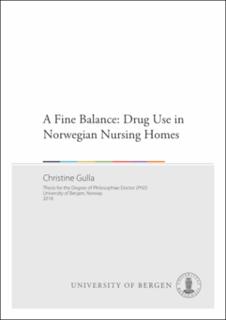| dc.description.abstract | Background: Today’s nursing home patients are old, fragile and suffer from multiple conditions. Consequently, they use on average seven different drugs each day. The total burden of these factors increases the vulnerability to drug related harm. The most common condition affecting nursing home patients is dementia, a disease that often renders the patients unable to express the harms and side effects of drugs. For this reason, we need to exhibit extra caution to avoid harming the patient. Aim: This thesis aims to explore how to optimize prescribing for Norwegian nursing home patients. The focus is on two of the major drug groups contributing to polypharmacy: psychotropics and antihypertensives. I will also describe the method and implementation of the medication reviews we used in the COSMOS study. Method: The thesis is based on a paper from an epidemiological study of three nursing home cohorts (Paper 1), and two papers from the COSMOS study (Paper 2 and 3). All patients included are 65 years or older and receive long-term care in Norway. Paper 1: A cross-sectional study of 4 793 patients from 129 nursing homes. Using ordinal logistic regression, we explored the association between the use of multiple psychotropic drugs and neuropsychiatric symptoms, common conditions, function, and dementia.Paper 2: A study on the development of the medication review process in the COSMOS study; an effectiveness-implementation cluster randomized clinical hybrid trial. The data is from the intervention group, N=297 patents. We describe the implementation by structured feedback on the process, barriers and promoters. Two researchers read the feedback, identified, and discussed the main messages. Paper 3: A cluster-randomized study using the COMSOS method investigating whether cognitive status affected change in number of antihypertensive used, and whether change in antihypertensives affected blood pressure or pulse. Data includes all patients using antihypertensives at baseline in the COMSOS study, N=295. The intervention group received a medication review with collegial mentoring and education in the COSMOS elements. The control group continued practice as usual. Mixed model analyses were used to compare the groups and investigate change over time for the patients at baseline, month four, and month nine. We used change in number of antihypertensive drugs used, systolic and diastolic blood pressure, and pulse as outcomes. Results: Paper 1: 73% of the patients used psychotropic drugs and 41% used two or more. Antidepressants were used by 39%, 30% used sedatives, 24% used anxiolytics, 20% used antipsychotics, and 14% used anti-dementia drugs. There was a strong association between neuropsychiatric symptoms and use of multiple drugs. Females, younger patients, patients independent in daily living, and patients with a diagnosis of dementia also used more psychotropic drugs. Paper 2: All intervention units in the COSMOS study conducted medication reviews with collegial mentoring during the first four months of the study and 92% of the patients received a medication review. Implementation facilitators were improved communication and enthusiasm towards the study and education. Barriers were lack of time, difficulties in involving the staff and physicians, and ethical dilemmas in relations to stopping treatment. Paper 3: The patients used on average 9.2 drugs, and 1.6 antihypertensives each. Mean blood pressure at baseline was 128/71 mmHg, 9% had high pressure and 5% low pressure. Some 32% of the intervention patients had at least one antihypertensive reduced between baseline and month four, compared to 10% on the control patients. For patients with a reduction in antihypertensive drugs, the systolic pressure rose on average 14 mmHg between baseline and month four, but returned to baseline level by month nine. Conclusion: The use of psychotropic drugs and antihypertensives is extensive among nursing home patients. Patients with dementia and neuropsychiatric symptoms receive more psychotropics. Dementia does not affect deprescribing of antihypertensives. Clinical medication reviews can lead to a reduction of antihypertensive drugs. To implement a complex intervention, one needs to involve all staff and set aside time to implement the intervention. The implementation can lead to greater enthusiasm towards the work and improved communication between staff, physicians, patients and relatives. Consequences: There is a need to improve the drug treatment for nursing home patients. By working together and using each other’s skills and knowledge, we can reduce the use of drugs and focus on the right treatment for the individual patient. This thesis demonstrates a method that includes systematic assessment of symptoms and a clinical medication review with multidisciplinary teams and collegial mentoring. | en_US |
| dc.relation.haspart | Paper 1: Gulla C, Selbaek G, Flo E, Kjome R, Kirkevold O, Husebo BS. Multi-psychotropic drug prescription and the association to neuropsychiatric symptoms in three Norwegian nursing home cohorts between 2004 and 2011. BMC Geriatr. 2016;16:115. <a href="http://hdl.handle.net/1956/12128" target="blank">http://hdl.handle.net/1956/12128</a> | en_US |
